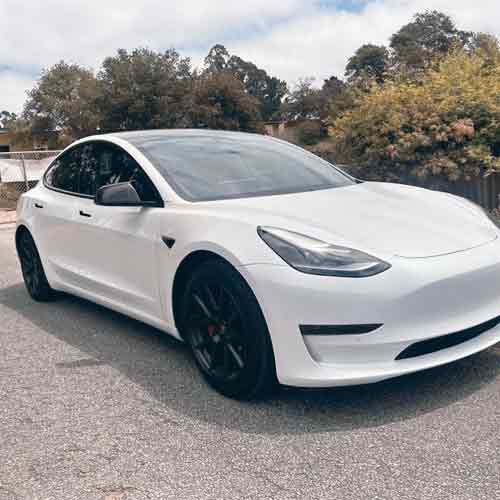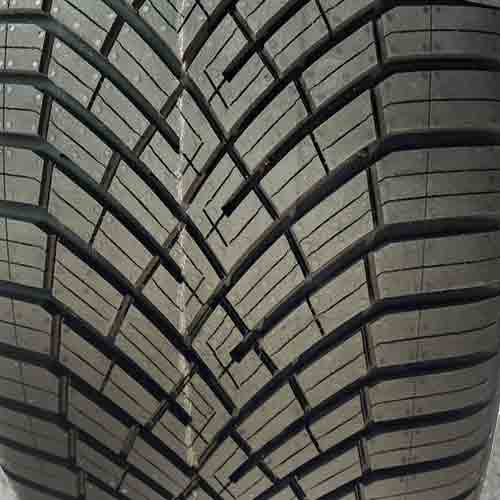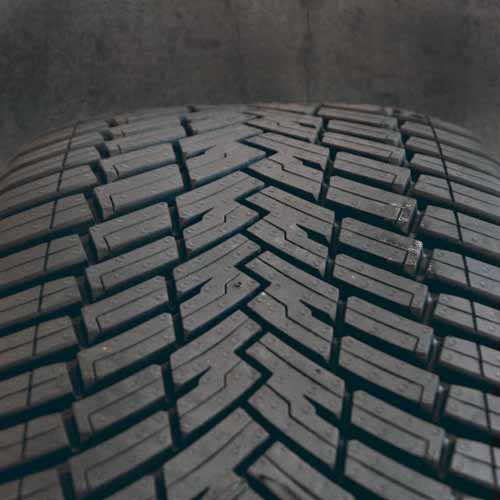Both the Continental AllSeasonContact 2 and the Pirelli Cinturato All Season SF2 hold prominent positions in the Grand Touring All-Season category, ensuring a combination of comfort, longevity, and dependable performance year-round. But which out of them is an ideal choice for you? Let’s find out!

Main Highlights
So overall, the Cinturato AS SF2 is better at:
- Dry-Road Braking: Offering enhanced overall braking due to its tight central lug design and greater biting power.
- Steering Responsiveness: Providing superior steering response, contributing to better overall handling and faster lap times.
- Noise Dampening: Excelling in reducing road noise with its special rubber mix and variable pitch tread design.
Detailed review of Pirelli Cinturato All Season SF2.
Whereas the Continental’s tire is better at:
- Wet-Road Performance: Demonstrating shorter stopping distances and better handling in wet conditions due to more effective siping and flexible rubber composition.
- Resistance to Curved Hydroplaning: Outperforming with its wider lateral grooves that effectively push water out sideways, enhancing grip during curved maneuvers.
- Snow Performance: Showing a slight edge in acceleration and braking on light snow due to its optimized central tread area for better snow-to-snow contact.
Detailed review of Continental AllSeasonContact 2.
Tread Features
Let’s start with the Continental AllSeasonContact 2, which comes with a directional tread pattern.

Looking at its design, it can be seen how its tread has five distinct segments, because of the longitudinal grooves, cutting the V shaped lugs.
The middle most area showcase U-shaped blocks, interspersed with notches.
These notches are interconnected by the U-shaped sipes.
Surrounding this core are ribs composed of smaller blocks, which feature linear sipes running parallel to the lateral grooves they make.
And shoulders?
Well these are elongated lugs, forming larger lateral grooves.
And yes, they also feature plus-shaped siping pattern.
Switching to the Pirelli Cinturato All Season SF2, this tire also employs a directional tread pattern, but with a more compact structure.

It features a V-shaped pattern, segmented into five distinct columns or ribs, similar to its Continental counterpart.
Though its more streamlined.
I mean you can easily picture the 5 circumferential grooves on the image, with the middle most exhibiting a zigzag pattern.
This zigzag structure enhances the tire’s water dispersion and hydroplaning resistance.
And is formed by the interlocking L (or F) shaped lugs, which also have notches on them, facing outwards.
Moreover, they also have linear sipes on them, though its also common with the rest of the ribs, on tread.
The shoulder lugs, though, have plus shaped siping pattern, very similar to AllSeasonContact.
Info on Sizes
Continental AllSeasonContact 2 comes in 15 to 21 inches, with sizes having following specs.
- Speed ratings: T, H, V, W and Y.
- Load ratings: SL, and XL.
- Weight range: 20 to 45 lbs.
- Tread depth: 10/32″.
- All sizes have the 3pmsf and M+S ratings.
- Some sizes have ContiSeal technology, (ideal for electric vehicles).
Pirelli Cinturato All Season SF2 comes in 65 total sizes, in 15 to 20 inches wheels. And they have the following specs.
- Speed ratings: H and V.
- Load ratings: SL and XL.
- Weight range: 16 to 32 lbs.
- Tread depth: 10/32″ (or 8 mm) on most sizes.
- UTQG: 500 A A.
- Treadwear warranty: None.
- All of them have the 3pmsf and M+S ratings.
- Some sizes also features run flat technology.
Important Note: Before you choose, make sure to visit our main page for the ultimate all-season tire recommendations.
Dry-Road Performance
The evaluation of dry performance hinges on three main categories: dry grip, handling, and steering response. I’ll discuss each category in detail.
Linear Grip
Linear grip refers to a tire’s ability to maintain traction in a straight line, primarily evaluated through its braking performance.
Now, the thing is, this kind of grip depends a lot on the tire’s middle part, the central tread area, as this is where most of the rubber contacts the road, as the tire rolls forward.
Having said that, it makes sense why the Pirelli Cinturato All Season SF2 excels in this regard, offering enhanced overall braking.
This tire has a tight central lug design, which means more rubber is touching the road, giving you better grip. Plus, it’s got greater comparative bite, with those lugs locking together, and forming more aggressive notches.
Moreover, it also offers a greater biting power too, as those lugs interlock with each other.
On the flip side, the Continental AllSeasonContact 2 lacks with its relatively spacious tread pattern, though its performance mostly gets affected here by its greater weight.
But why does this matter?
Well, a lighter tire means less weight on each lug, spreading out the pressure on the rubber. This reduces the tire’s momentum, facilitating quicker and more efficient braking.
Overall Handling
Simply put, the overall handling depends (mostly) on lateral grip and steering response.
The lateral grip comes mostly from the tire’s edges, the shoulders and sidewalls. That’s because when you turn, the car’s weight shifts to the opposite side, making the shoulders the primary point of contact with the road.
Now comparing both tires, they’re kind of similar in terms of traction, as indicated by lateral G-forces.
Though as the Cinturato All Season SF2 provides better steering responsiveness, it excels in overall handling, showcasing a second faster on lap tests (on average).
The tire responds precisely and quickly to various driving inputs, which is basically a result of its well engineered internal structure, incorporating spirally-wound nylon cords, enhancing the stability.
Additionally, the Pirelli’s design features smoother, curved V-shaped grooves, which facilitate a more seamless weight transition across the tire’s shoulders and central ribs during cornering maneuvers.
In contrast, the Continental AllSeasonContact 2 is is a bit behind here, again due to its relatively heavier weight and more void spaces in the rubber.
Though this is particularly noticeable on sizes with ContiSeal technology.
This tech. although adds to the tire’s durability, it also increases weight, which stresses out the lugs (on tread) more, making them more prone to bending.
This bending is very affecting, as deformed lugs take time to revert to their original shape, creating a delay between the driver’s input and the tire’s response.
Ride Quality
Ride comfort in tires is primarily influenced by three factors: stability, efficiency in smoothing out road imperfections, and noise reduction.
Let’s dive into these.
Noise Dampening
Besides the rubber-road interaction, noise also emerges when air particles get in, from sides of the tire, and hit the tread walls. This noise then creates in-groove resonance, which often leads to cavity sounds.
And here, the Pirelli is a rock star, in dampening all these unwanted sounds, providing you superb dampening performance. This is because the tire’s design is all about reducing noise, when you’re cruising down the road.
It offers:
- Special Rubber Mix: where it offers a unique rubber formula. This special mix is basically really good at soaking up noise instead of bouncing it back. It’s like having a built-in sound absorber.
- Variable Pitch Tread: where it offers a varied tread pattern, which basically means it creates different tones and frequencies as air hits the tread walls. It’s like having a bunch of different notes playing instead of just one loud noise.
Thanks to these, the Cinturato SF2 provides leading performance. In fact this is very reason why I decided to add this tire in my list of top grand touring all-season tires.
You can check out my list here: https://tiredriver.com/best-grand-touring-all-season-tires/
Vibrations Comfort
When it comes to the comfort you feel on the road, a lot of factors play a role, like the tire’s internal structure, external build, tread makeup, and design.
And here both tires end up getting equal comfort scores, based on my subjective evaluations.
Both of them offer a really nice mix of comfort and control. And they offer firm damping, which means they handle big bumps smoothly and pretty much get rid of the small ones, making your ride super comfortable.
However, there’s a bit of a twist with some sizes of the AllSeasonContact 2, especially those with the Conti-Seal System.
This system basically makes the internal structure of the tire, stiffer. And because of this, in some cases, the Pirelli tires end up performing a little better overall.
So, if you’re looking at those specific Continental tire sizes, you might find the Cinturato SF2 a better fit for a smooth ride.
Snow Performance
Now both of these boys offer a great combination of summer and winter tires.
They rock on dry and wet roads and also give you top-notch braking, acceleration, and handling in snow and ice (comparing other tires in the category).
And yes, of course, both tire come with branded 3-peak mountain snowflake rating (which is given to tires which are at least 10% better compared to standard touring all-season tires, (view more info on 3pmsf and m+s ratings).
Now based on my comprehensive tests, and subjective evaluations, both tires perform neck to neck, so you can’t really go wrong with either one of them.
Now, I’ve done a bunch of tests and honestly, these tires are so close in performance, you can’t really go wrong with either. But, just to nitpick a bit, the Continental has a slight edge in acceleration and braking on light snow, while the Pirelli is a bit better at handling snow.
This is because comparatively, the AllSeasonContact 2 offers a better snow-to-snow contact from its central tread area, thanks to its U shaped blocks there.
Whereas the Pirelli offers a more optimized (for snow) shoulders, providing better snow contact form there.
Why does this type of contact matter? Well, because snow particles stick to each other better than they do with rubber, so the way tires grab and hold snow is super important.
Wet-Road Performance
Wet performance largely depends on the tire’s ability to disperse water from its tread, focusing on traction and hydroplaning resistance.
Let’s review how the tire fares in each of these aspects.
Wet Grip and Handling
Now, water clearance from a tire’s surface is primarily achieved through grooves and sipes.
Grooves do most of the heavy lifting by moving a lot of water out of the way, and sipes take care of the leftover moisture, which is super important for keeping a good grip on wet roads.
Here’s the deal with sipes: they work by bending and creating a sort of vacuum that sucks up water, letting the tire stay in touch with the road.
Now, talking about the Continental AllSeasonContact 2, the tire although lacks on dry a little, it’s a real champ in wet conditions.
This is because, the tire offers sipes, which are not only more in quantity, in comparison to Pirelli, but also come with a more effective design and greater flexibility.
Additionally, the rubber composition of the Continental tire is more flexible. Which is very important, as this flexibility aids the sipes in effectively capturing water particles, a feature that is less pronounced in the Pirelli Cinturato.
That’s why the AllSeasonContact 2 offers 5 feet shorter stopping distances, (when braked from 60 mph), and half a second faster wet handling lap times, on my “averaged” conducted tests.
Learn are all-season tires good in rain? (I discussed out things further here).
Resistance to Hydroplaning
Hydroplaning occurs when a layer of water builds up between a tire and the road, causing the tire to lose traction and essentially float, or you can say, hydroplane.
Now, to counteract this, tires are designed with grooves.
Meaning, the better these grooves are at moving water out of the way, the less likely you’ll find yourself hydroplaning.
Now, both boys here, coming with prominent V-shaped voids, excel in overall hydroplaning resistance. However, distinct differences emerge upon closer examination. Let me share them.
So, the Pirelli SF2 excels in straight-line hydroplaning resistance, due to its more streamlined circumferential grooves.
These basically efficiently channel water “longitudinally”, improving the tire’s ability to maintain traction at higher straight float speeds.
On the flip side, the Continental AllSeasonContact 2 shows superior performance in curved hydroplaning scenarios.
It’s got these wider lateral grooves that, along with its heftier weight and smartly designed contact patch, do a great job at pushing water out sideways.
And this means better grip and control when you’re curving around.
For Your Info: Float speeds is the speed at which a tire begins to float. To analyses it, tires are ran in a straight line, and in curves, on a few mm deep water. And a telemetry system is utilized to accurately record the exact moment when the tires lost traction.
In Summary
As we near the finish line in our comparison, let’s take a final glance at how both tires match up against each other.
Now, the Pirelli excels in dry-road performance with enhanced overall braking, along with superior steering responsiveness contributing to faster lap times and better overall handling.
Though in wet conditions, its not the same, where the tire lacks in both wet traction and resistance to aquaplaning.
In snow performance, both tires are closely matched, each offering specific advantages in acceleration, braking, and handling on light snow.
Ride comfort is another strong suit for both, with the Pirelli standing out in noise dampening due to its special rubber mix and variable pitch tread, while the Continental’s Conti-Seal System in some sizes may impact its comfort ratings slightly.